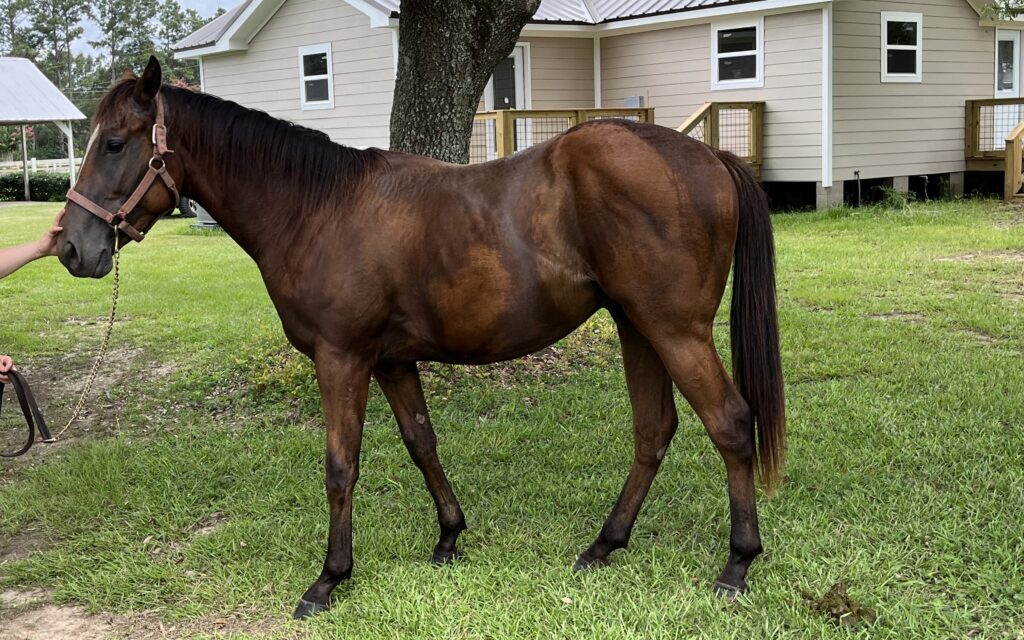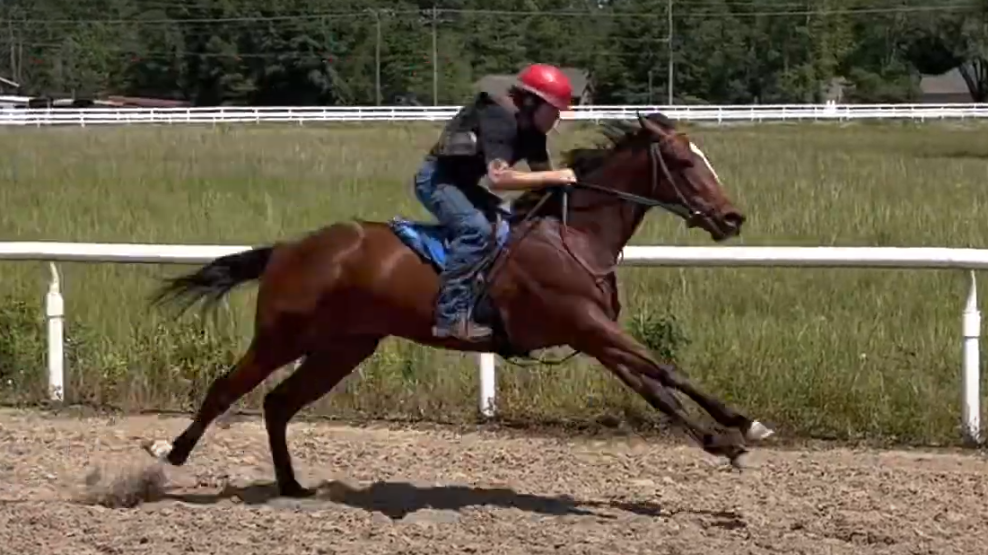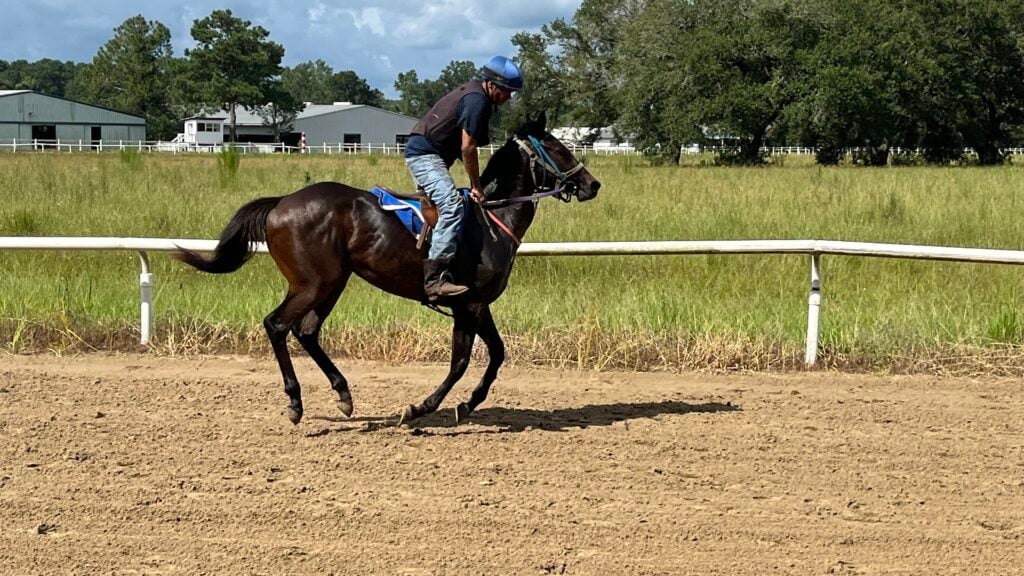Last updated: August 5, 2022
Any links on this page that lead to products on Amazon are affiliate links and I earn a commission if you make a purchase. Thanks in advance – I really appreciate it!
We all enjoy riding our horses, but how often is too much? My granddaughter has a new horse and is riding it every day, is this too often?
It’s OK to ride your horse every day, but not advisable to work your animal strenuously during each outing. Horses need recovery time after vigorous exercise, just like human athletes.
Many people think the more you ride, the better, but often the opposite is true. There’s a lot to determining how often a horse should be ridden, and what works for one may not work for all.

A horse’s fitness level determines how often you should ride.
You want to ride your horse every day, but you need to be mindful of its fitness level. When I was young, I lived with my grandparents on their ranch. My grandfather trained young horses and typically rode each one six days a week.
But every animal wasn’t subjected to the same routine. My grandfather carefully watched his horses and worked them based on their level of fitness.
He always kept in mind that these beautiful animals are individuals and advance uniquely. He knew that overworking a horse leads to problems and training setbacks.
The horse pictured above is a two-year-old colt we turned out for two months. We will start riding him a couple of times a week and put him on the walking wheel on his days off. He’s definitely not in shape for everyday riding.
It’s good to ride frequently.
Riding helps keep a horse healthy and fit. If you pleasure ride, spending most of your time walking or slow trotting, there is no reason you shouldn’t ride your horse every day.
For most of us, horseback riding is a pleasure, but for some people, it’s the last thing they want to do. Children and adults often buy their first horse and soon lose interest. But keeping your animal in shape is an owner’s responsibility.
Animals, like people, are healthier, and their organs function better when they are physically fit. To get your horse in shape, it needs exercise. Formal exercise is essential for animals that spend the majority of their time in stalls or small paddocks.
There are a few different ways to keep your horse in shape, but the most common methods are riding and lunging. We also incorporate an electric walker on days we don’t ride.
If you ride every day, be sure at least three of those days are easy riding. Also, pay attention to your animals’ level of fitness and adjust your riding schedule accordingly.

Use a riding schedule to get your horse fit.
The critical factor to base your training schedule on is this: horses are individuals and advance at their rate. Don’t consider any training regime to be absolute, but rather a guide for you to modify for each animal.
If you’re riding multiple horses per day, use a method to keep track of the time you spend with each one. Note the duration of the ride, intensity level, and how the animal recovered, especially if you notice something unusual.
Keeping a log of your rides keeps you informed so you can regularly make adjustments. A horse’s fitness level plateaus if its exercise routine isn’t varied.
So plan rides of different lengths and duration to get the most out of your training. If you’re like me, notes are necessary to keep up with what I’ve done with each horse.
An important consideration is to make sure your animal is sound before you begin a rigorous exercise.
Riding Program
First week
If I have a sound horse, but it needs to get into better shape, I’ll start riding it for 30 minutes to an hour a day for the first week. I am spending most of the time walking at an alert pace with a few intervals of short trotting.
Do this 4-5 times a week and pay attention to its ability to recover after each trotting interval.
Second week
I suggest continuing to ride 4-5 days a week for 45 minutes to an hour each day. If your horse recovered fine in the first week, increase the trotting intervals. Keep an eye on the time it takes to recover; ideally, you’d like to pick up the pace every 15 to 20 minutes.
Third week
Keep going 4-5 days a week but ride an hour each a day and increase the trotting time. For three of the riding days introduce a short period of galloping. Again monitor your animal’s recovery and adjust your trotting and galloping accordingly.
Fourth week
Continue riding 4-5 times a week but step up the duration of trotting and galloping. Your goal is to spend three of the days riding for an hour with 30 minutes of trotting and 5 minutes of galloping. Hopefully, your animal is tolerating this well and recovering within ten minutes.
Fifth week
During the fifth week, ride for 5 or 6 days and spend three days trotting for 40 minutes and ten minutes galloping. For the remaining one or two days, slow trot and walk at a leisurely pace.
Always monitor your horse after every training day, noting his recovery time. Also, be conscious of dehydration; an animal loses a lot of moisture during training, especially in hot climates.

Fitness
Breathing and heart rate
To ensure you’re not pushing your horse too hard, watch how it recovers after extensive riding. If your animal is fit and in good shape, its heart rate and breathing should return to its normal level within 10 minutes after you stop working.
Horses that are overweight or out of shape pant, and their heart rates remain elevated for a long time after working. If your animal doesn’t recover in 15 to 20 minutes, the animal may have a respiratory issue and should be examined by a veterinarian before your next ride.
Sore muscles
Muscle soreness that lingers after exercise is sometimes referred to as secondary muscle pain. It’s a relatively common occurrence and has numerous causes, including fitness levels, diet, improper fitting saddles, shoeing, and joint pain.
Recognizing secondary muscle pain isn’t easy, but the symptoms are behavioral changes under saddles, such as not wanting to move forward, bucking tail swishing, and changes in overall demeanor.
If your horse exhibits secondary muscle pain or stiffness after working, you likely pushed the animal too hard for its fitness level. When this happens, give him some time off of training to recover. After his break, start working him at a reduced exercise level and bring him slowly into shape.
To prevent muscle soreness and stiffness, some owners incorporate chiropractic care, stretching, and massage. These treatments do help control soreness, but your best option is to progress slowly and match your training with your animals’ fitness level.

Fatigue and Lethargy
Overworked horses fatigue and begin to struggle to maintain their intensity level. When this happens, it’s important to back off of training because continuing to push animals increases the chance of injury.
Horses asked to perform fatigued are likely to stumble and sustain damage to their tendons. If an animal continues to be pushed beyond standard fatigue, they are at risk of colic, tying up, and suffering heat exhaustion.
An animal’s fitness level influences how quickly it fatigues. So it is essential to build up fitness levels before asking your animal to work hard. The better condition of your animal, the longer it can exercise without getting tired.
I recently ordered a heart rate monitor so I could check how long my horses take to recover after working hard. This will allow me to adjust my training schedule and not harm my horses.
The monitor I’m using is made by Polar; it was simple to set up and use. You do need to have an iPhone or iPhone watch to download their app and sync it with the monitor on your horse.

An exhausted animal will typically move at a slower than usual pace, have decreased responsiveness, and display reduced coordination. These animals may also seem unmotivated or refuse to change gaits.
Horses may also seem unresponsive the day following strenuous work. If this is the case with your animal, then give him some time off or reduce his workload so he can fully recover.
The final word on riding daily
One key question horse owners must ask themselves is how often their horse should be ridden. While there is no definitive answer, there are some guidelines that can help horse owners make the best decision for their animals.
First and foremost, it’s important to consider the horse’s age and condition. Young horses, in particular, may need more frequent rides in order to stay healthy and fit. Senior horses may need less exercise, as they may be more susceptible to injury.
In addition, horse owners should take into account the horse’s breed and type. Some breeds are more suitable for regular riding than others. Ultimately, the best way to determine how often a horse should be ridden is to consult with a veterinarian or experienced equestrian.
With their help, horse owners can ensure that their animal is getting the exercise it needs without putting its health at risk. But in general, it’s Ok to ride daily, just be aware of your animals’ fitness level and use common sense.
Below is a helpful YouTube video concerning how often you should ride your horse.
Related articles
- Is My Horse Overweight? A Plan To Reduce Weight Safely.
- Is My Horse Dehydrated? 10 Clear Signs of Equine Dehydration
- What is Colic in a Horse? Causes and Symptoms
- How Much Weight Does a Horse Lose In a Race?
- How Far Can a Horse Travel in a Day? The Essential Factors
- The 3 Types of Horse Riding Styles You Should Know About

About the Author: Miles Henry
Lifelong Horseman | Racehorse Owner | Published Author
Miles Henry brings over 25 years of hands-on experience training and owning Thoroughbred racehorses. Raised with Quarter Horses and Appaloosas, he’s spent a lifetime learning from horses—on the track, in the barn, and in the field. Today, he runs a small but successful racing stable in Louisiana and shares real-world insights on HorseRacingSense.com, helping horse owners, fans, and bettors navigate the sport with confidence.
📚 Books: View Miles’s books on Amazon »
🎧 Podcast Guest: Animal Tales Ep. 32 |
YouTube Interview
📩 Newsletter: Sign up for racing tips and horse care advice »
🔗 Follow Miles:
Twitter |
Facebook |
YouTube


